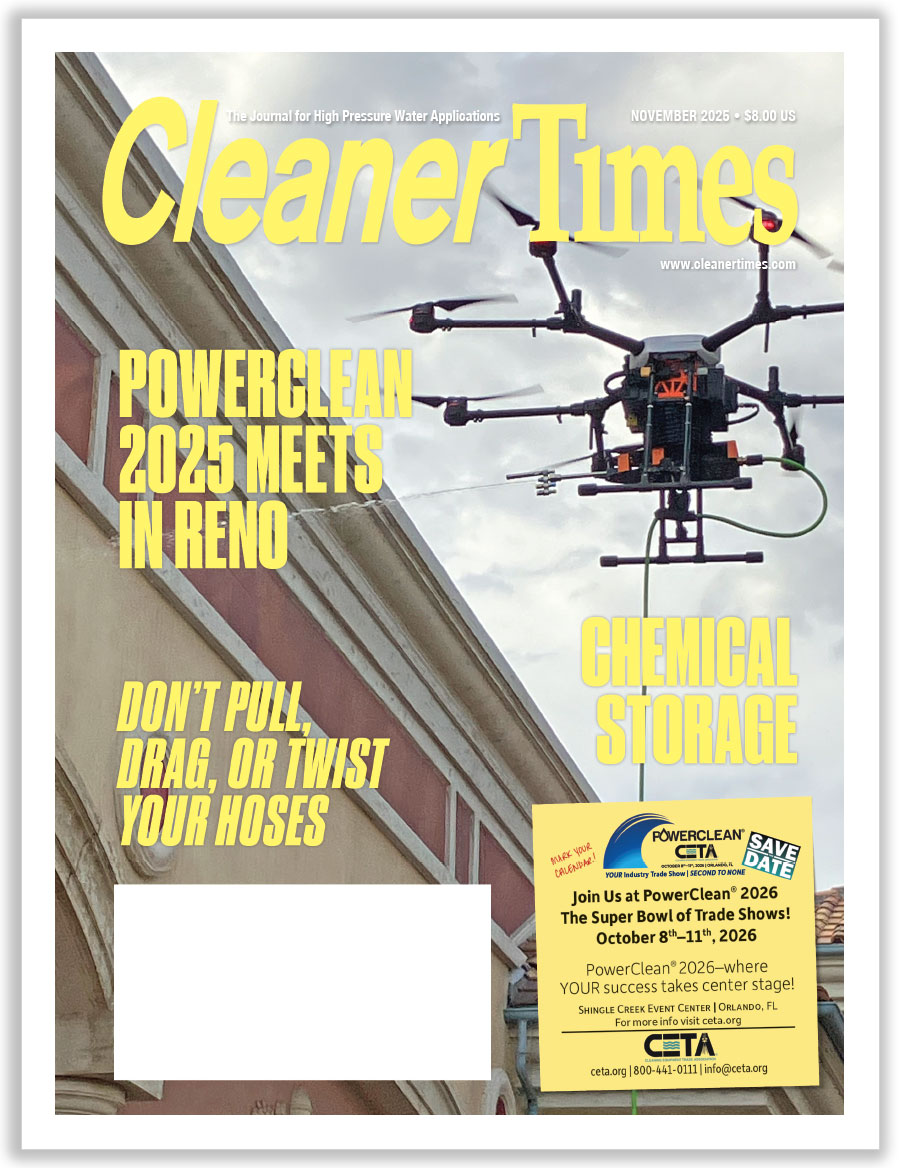
Financial
Losses—Waste Not
By Mark E. Battersby / Published September 2020

This may be the year for losses, substantial losses in some cases, but those losses don’t have to be a bad thing. The Coronavirus Aid, Relief, and Economic Security (CARES) Act, as one example, temporarily allowed net operating losses (NOLs) to be carried back to earlier tax years. The result is a refund of taxes paid in those earlier, more profitable years and an infusion of badly needed cash.
Just as many pressure cleaning contractors and business owners were focused on building their businesses, their world took a nosedive. The focus, for many, should now be on survival. And, the usual legal manipulation of deductions, postponing many deductible expenditures into the future, hopefully more profitable years, may not be the only answer. Taking full advantage of those almost inevitable losses might be the key to survival.
Operating Losses
When the losses, combined with the operation’s other deductions, exceed its income, the result is a net operating loss (NOL). The Tax Cuts and Jobs Act (TCJA) passed in 2017 limited the amount of NOLs that could be utilized to only 80 percent of taxable income without the NOL. Even worse, after the TCJA, NOLs could only be carried forward…until today.
The CARES Act allows NOLs arising in a taxable year beginning after December 31, 2017, and before January 1, 2021, the possibility of being treated as a carryback to each of the five preceding tax years—unless the taxpayer chooses to forgo the carryback.
Businesses that incur NOLs in 2018, 2019, or 2020 can carry back those losses as far as 2013, 2014, and 2015 respectively. Considering the maximum corporate tax rate for tax years prior to 2018 was 35 percent rather than today’s current 21 percent corporate tax rate, the carrybacks can be quite rewarding. Of course, for tax years 2021 and thereafter, the old rules, including the previous 80 percent of taxable income limitation, will be reinstated.
To claim a refund of taxes from an NOL carryback, either a single tentative refund claim covering all carryback years or an amended tax return for each carryback year can be used. With the IRS required by law to process the refund request within 90 days, Form 1045 or Form 1139 are the preferred forms.
Individuals file a tentative refund claim on Form 1045, Application for Tentative Refund, while incorporated pressure cleaning businesses use Form 1139, Corporate Application for Tentative Refund. These forms eliminate the burden of filing multiple amended returns to account for each carryback year if the NOL is not fully absorbed in the first carryback year.
The Downside of NOLs
Taking advantage of the new, and temporary, NOL carryback rules allows pressure washing businesses to quickly free up cash flow. It may also open a pandora’s box on several levels. Thus, some thought should be given to carrying back NOLs to tax years closed by the statute of limitations as well as to years when cancellation of debt income may have been allowed.
State tax implications should also be a consideration when carrying back NOLs. Ensuring that carrybacks are properly claimed at the state level and that the statute of limitations does not inadvertently get extended are other considerations. It is also expected that many states will “decouple” from the five-year carryback as they have in the past when NOL disaster relief was enacted.
Casualty Losses
Personal casualty losses are generally no longer deductible. That’s right, the deduction for an individual’s personal casualty losses not connected with (1) a trade or business or (2) a transaction entered into for profit has been eliminated.
Businesses can, of course, continue to take casualty loss deductions for losses that occur as a result of fires, natural disasters, and other casualties. There is also an exception for both individuals and businesses for losses attributable to a federally declared disaster when losses can be taken in the year they occur or, if an election is made, in the prior year to produce a refund of previously paid taxes.
A nationwide emergency in response to the coronavirus pandemic was declared in early March, making the tax law’s Section 165(i), Disaster Losses, rules that most often kick-in in the wake of an actual storm or other natural disaster potentially invaluable for many pressure cleaning businesses. Quite simply, Section 165(i) allows 2020 coronavirus losses to be claimed on last year’s tax return.
Section 165(i) doesn’t allow a deduction for general losses, but even in the absence of the physical damage of a natural disaster, it does give a contractor or business owner the option of taking a loss deduction for the year before the year in which the loss was actually sustained.
To claim a loss under Section 165(i), the pressure cleaning business must be able to show the property losses were directly caused by the coronavirus pandemic (i.e., an “identifiable event” requirement). Plus, it must be shown that (1) the loss could not be reimbursed through insurance or otherwise, (2) the loss can be evidenced by “closed and completed transactions” and (3) the loss was related to the disaster and sustained in the year when the disaster occurred.
Section 165(i) is particularly beneficial for businesses with damaged inventories. Those businesses have the option of choosing whether to account for the losses through inventory adjustments or the disaster loss rules. Inventory sold at a loss, donated to charity, or expired or spoiled due to the operation’s closure can all be deducted as Section 165(i) losses.
While general lost revenue declines in fair market value and loss of goodwill cannot usually be deducted under Section 165(i) because the provision applies to “property” losses, a pressure cleaning business that has permanently closed its facility, abandoned pending business deals (at least for costs already capitalized), and made termination payments based on canceled contracts or deals can also benefit from accelerating Section 165(i) losses back to 2019.
In fact, pushing the 2020 losses into 2019 could generate larger net operation losses (NOLs) that, as mentioned, can be carried back to earlier tax years when the business may have been more profitable. Even better, the earlier cap on the amount of business losses that could be deducted by some taxpayers has been lifted.
Excess Business Losses
Under the TCJA, “Excess Business Losses” (EBLs), the excess deductions from all trades or businesses over any gain, the individual’s losses above $250,000 (or $500,000 if spouses file a joint return) could no longer be deducted. Fortunately, the CARES Act removed the limitation on excess business losses for so-called non-corporate taxpayers going all the way back to 2017.
The new, temporary rules allow noncorporate taxpayers to fully offset taxable income with business losses for the 2018, 2019, and 2020 tax years—even if those losses are not related to the coronavirus pandemic. For tax years beginning in 2021 through 2026, taxpayers may treat excess business losses as NOLs for the purpose of determining a net operating loss carryover in the following year.
For partnerships, S corporations, and other pass-through business entities, the loss limitation is applied at the partner or shareholder level, not at the entity level. Regardless of the amount of business losses a noncorporate taxpayer may have, the taxpayer(s) very likely could have taxable income subject to tax.
Because the EBL rule is applied by aggregating a taxpayer’s business income and deductions, it doesn’t prevent taxpayers from offsetting losses of one business against the income of another business. Any EBL will carry forward under the NOL rules, subject to the limitations.
The Future
What happens next year? The CARES Act repealed the 80 percent income limit for NOL carryovers deductible before January 1, 2021. Thus, taxpayers can utilize NOLs to offset 100 percent of taxable income in tax years 2018, 2019, and 2020, affecting those who will have a NOL for the current year.
The five-year NOL carryback provides a welcome injection of liquidity for many pressure cleaning businesses suffering from the economic impact of the coronavirus pandemic. Remember, however, that relief is only temporary.
For corporate taxpayers, NOLs carried back to pre-2018 years—when corporate tax rates were 35 percent—are more valuable than losses used to offset income taxable at the current 21 percent tax rate. In other words, an incorporated pressure washing business can carry back its 2018, 2019, and 2020 NOLs to offset pre-2018 ordinary income or capital gains that were taxed at rates of up to 35 percent.
Whether as a result of economic conditions, competition, or factors outside the control of the owner or operator, every business is at risk of losses. Would a refund on taxes paid by the formerly profitable operation in years past help ease the pain of lingering losses this year? What if last year’s losses from the business could be used to offset next year’s profits and reduce the tax bill for years to come?
Obviously, recoveries via tax law are not always smooth, often requiring professional assistance or, at the very least, an understanding of how the tax rules work. But it is worth considering if you or your pressure cleaning business could profit from this year’s losses.






